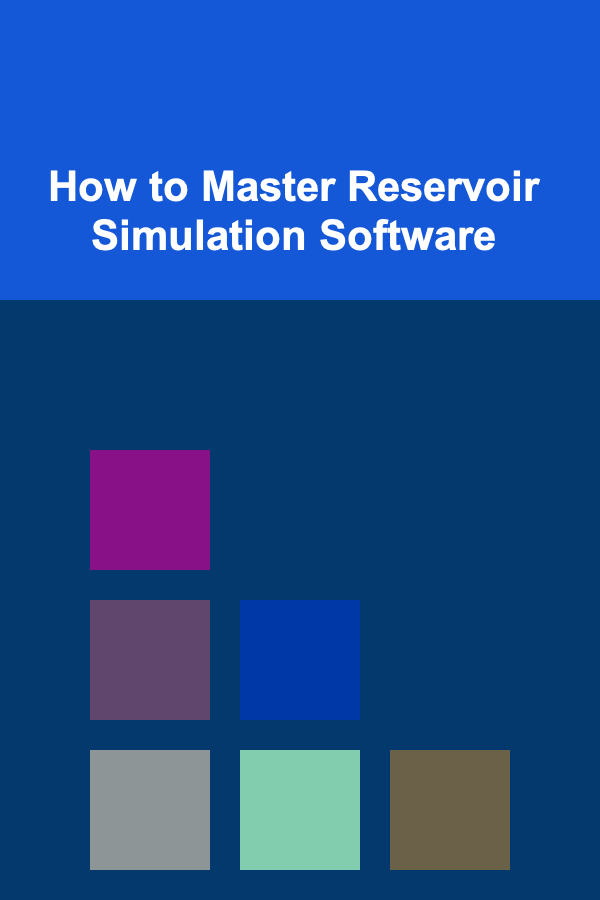
How to Master Reservoir Simulation Software
ebook include PDF & Audio bundle (Micro Guide)
$12.99$5.99
Limited Time Offer! Order within the next:

Reservoir simulation is one of the most crucial aspects of petroleum engineering, allowing professionals to model and predict the behavior of oil and gas reservoirs under different production scenarios. Reservoir simulation software provides engineers with a detailed virtual environment where they can optimize the extraction process, forecast future production, and make decisions that will impact both economic and operational efficiency. However, mastering this specialized software requires not just technical know-how, but a strategic approach to training, practice, and ongoing learning.
In this article, we will explore how to master reservoir simulation software, from understanding its core principles to acquiring the technical skills necessary for effective use. Whether you are a novice looking to get started, or an experienced engineer aiming to refine your skills, this comprehensive guide will walk you through the key steps to mastering reservoir simulation software.
Understanding the Basics of Reservoir Simulation
Before diving into the specifics of the software itself, it's essential to understand the basic principles behind reservoir simulation. Reservoir simulation is the process of creating a model that replicates the behavior of a reservoir under different conditions, allowing engineers to predict how the reservoir will behave over time. The goal of simulation is to optimize the recovery of hydrocarbons while minimizing costs and environmental impact.
Key Concepts in Reservoir Simulation
- Reservoir Models: Reservoir models are mathematical representations of underground reservoirs, which simulate fluid flow and reservoir behavior. These models typically include information such as reservoir geometry, rock and fluid properties, boundary conditions, and well placement.
- Flow Equations: Reservoir simulation software relies heavily on solving flow equations that describe how fluids (oil, gas, and water) move through porous media. These equations are based on principles of fluid dynamics, thermodynamics, and mass conservation.
- Grid Blocks: Reservoirs are often divided into a grid of cells or blocks in simulation software. These grid blocks represent different sections of the reservoir, with each block containing information about rock and fluid properties.
- Well Models: Wells are the interface between the reservoir and the surface. The software models the behavior of wells based on factors such as pressure, flow rate, and production history.
Types of Reservoir Simulation Models
- Black-Oil Model: This is the simplest type of reservoir model, which assumes that the reservoir fluids can be represented as oil, gas, and water. The black-oil model is commonly used for conventional reservoirs.
- Compositional Model: This model takes into account the detailed chemical composition of the reservoir fluids. It is used for more complex reservoirs where phase behavior and fluid properties are important.
- Thermal Model: This model simulates the behavior of reservoirs under thermal recovery methods such as steam injection. It accounts for heat transfer and the effects of temperature on fluid properties.
Selecting the Right Reservoir Simulation Software
There are several popular reservoir simulation software programs in the market, each offering different features and capabilities. Choosing the right software for your needs depends on the complexity of your reservoir, the specific objectives of your simulation, and the software's compatibility with your team's workflow.
Popular Reservoir Simulation Software
- ECLIPSE: ECLIPSE by Schlumberger is one of the most widely used reservoir simulation software. It offers a comprehensive set of tools for modeling reservoir dynamics, including options for black-oil, compositional, and thermal models.
- CMG (Computer Modelling Group): CMG offers a suite of simulation tools, including STARS (thermal recovery), GEM (compositional modeling), and IMEX (black-oil modeling). CMG software is known for its accuracy and versatility, particularly in complex reservoir simulations.
- Reservoir Simulation by Petra: Petra offers software that integrates geological, geophysical, and reservoir data to create detailed simulations. It is particularly useful for creating reservoir models in unconventional reservoirs.
- TNavigator: This simulation software by Rock Flow Dynamics provides an advanced, flexible solution for reservoir modeling, including real-time data integration and advanced reservoir management capabilities.
- ROXAR: ROXAR's reservoir simulation software provides robust tools for dynamic reservoir modeling and is widely used for integrated reservoir management and optimization.
Key Factors to Consider When Choosing Software
- Ease of Use: The software's interface should be user-friendly and intuitive, allowing users to focus on modeling rather than struggling with complicated setups.
- Accuracy and Performance: Reservoir simulation can involve large and complex datasets. The software should be capable of handling these efficiently, providing high accuracy and performance even for larger models.
- Customization and Flexibility: Depending on your project requirements, you might need software that allows for customization and flexibility in defining reservoir properties and simulation parameters.
- Support and Community: Having access to technical support and a strong user community is crucial. Look for software with a large user base and readily available support materials, tutorials, and forums.
Learning the Software Interface and Tools
Once you've selected the right reservoir simulation software, the next step is to familiarize yourself with its interface and tools. Modern reservoir simulation software packages come with a wide range of features, and mastering them requires a structured approach.
Familiarizing Yourself with the User Interface
Most reservoir simulation software includes graphical user interfaces (GUIs) that help you visualize your reservoir models, manipulate data, and run simulations. Start by exploring the following elements:
- Project Workspace: The workspace is where you create and manage projects, load data, and organize files related to your simulations.
- Modeling Interface: This is where you build and edit your reservoir model, including setting up grid blocks, inputting reservoir properties, and defining well locations.
- Data Input and Output: Understanding how to import and export data is crucial. Most reservoir simulation software supports integration with external data sources such as geological surveys, well logs, and production data.
- Simulation Controls: Learn how to set up simulation parameters such as time steps, boundary conditions, and flow equations. Many software tools also allow you to run sensitivity analyses, which can help assess the impact of various input parameters on the results.
- Visualization and Results: One of the key features of reservoir simulation software is the ability to visualize results through graphs, contour maps, and 3D visualizations. Familiarize yourself with the software's visualization tools to interpret the simulation results effectively.
Software-Specific Tools and Features
Each software package offers unique features and tools. For instance:
- ECLIPSE: ECLIPSE offers advanced features such as dual-porosity modeling and reservoir management. It supports large-scale simulations and can be used for both conventional and unconventional reservoirs.
- CMG: CMG software includes a highly detailed compositional solver and advanced reservoir management features, which are particularly beneficial for complex reservoirs like shale oil and gas.
- TNavigator: TNavigator integrates data from real-time production, making it useful for ongoing reservoir management and optimization. It also includes tools for data integration and uncertainty analysis.
Acquiring Core Skills for Reservoir Simulation
Mastering reservoir simulation software involves developing a range of technical skills that are critical for building accurate models and running successful simulations. These skills include:
1. Understanding Reservoir Fluid Behavior
A deep understanding of how fluids behave under various reservoir conditions is essential. This includes knowledge of phase behavior, pressure-volume-temperature (PVT) relationships, and fluid composition. The ability to input accurate fluid properties into your simulation model will significantly improve the reliability of your results.
2. Modeling Reservoir Geology
Reservoir geology plays a crucial role in simulating fluid flow. Understanding the heterogeneity of the reservoir, including variations in porosity, permeability, and reservoir thickness, is essential for creating accurate models. You'll need to incorporate geological data such as core samples, seismic surveys, and well logs into your reservoir model.
3. Creating Grid Blocks and Structuring Your Model
Properly structuring the grid blocks in your reservoir model is a critical skill. The grid should be fine enough to capture key reservoir features but not so fine that it results in excessive computational demands. Understanding how to balance grid resolution with computational efficiency is a key challenge in reservoir simulation.
4. Defining Boundary Conditions
Boundary conditions define the interaction between the reservoir and its external environment, such as aquifers, faults, or the surface. Accurately defining these conditions will improve the accuracy of the simulation results.
5. Running Simulations and Interpreting Results
Once your model is set up, the next step is to run simulations. Understanding how to interpret the results---whether they be production forecasts, pressure profiles, or saturation maps---is crucial for making informed decisions about reservoir management. This involves a deep understanding of reservoir behavior and the ability to troubleshoot and adjust your model as necessary.
Advanced Techniques and Optimization
As you become more proficient with reservoir simulation software, you can start exploring advanced techniques and optimization strategies to enhance your simulations.
Sensitivity Analysis
Sensitivity analysis involves testing how changes in input parameters (such as rock properties or well placements) affect the outcome of your simulation. This helps you identify the most influential parameters and optimize them for better reservoir performance.
History Matching
History matching is the process of adjusting your simulation model to match historical production data. This ensures that your model accurately reflects actual reservoir behavior, allowing for more reliable predictions of future performance.
Uncertainty Analysis
In real-world reservoir simulation, there's always a degree of uncertainty. Uncertainty analysis helps you quantify the level of uncertainty in your results and make decisions that account for potential risks. This can be done through Monte Carlo simulations, where you run multiple simulations with varied input parameters to generate a range of possible outcomes.
Field Development Optimization
Once you have a good understanding of your reservoir, you can use the simulation to optimize field development. This includes determining the best well placement, designing enhanced oil recovery (EOR) strategies, and making decisions about future drilling campaigns.
Staying Updated with New Software Features and Techniques
The field of reservoir simulation is constantly evolving, with new software features, algorithms, and techniques emerging regularly. To stay competitive and improve your skills, it's important to keep learning and stay updated on the latest developments in the field.
- Training and Certifications: Many software providers offer formal training programs, workshops, and certifications that can help you deepen your knowledge and improve your technical expertise.
- Industry Conferences and Seminars: Attending industry conferences, webinars, and seminars can provide valuable insights into new trends, tools, and techniques in reservoir simulation.
- Online Communities and Forums: Participate in online communities and forums where professionals share their experiences, troubleshoot issues, and discuss best practices for reservoir simulation.
Conclusion
Mastering reservoir simulation software is a multi-faceted journey that requires a combination of technical knowledge, hands-on practice, and continuous learning. By building a solid understanding of reservoir principles, selecting the right software, learning the interface, acquiring core technical skills, and exploring advanced optimization techniques, you can effectively leverage reservoir simulation software to enhance reservoir management, optimize production, and make informed decisions. Whether you are new to the field or looking to refine your skills, this guide provides a solid foundation for mastering reservoir simulation software and becoming an expert in this critical area of petroleum engineering.
Reading More From Our Other Websites
- [Organization Tip 101] How to Organize Your Attic or Basement for Functionality
- [Personal Care Tips 101] How to Use Hair Mousse on Dry Hair: A Comprehensive Guide
- [Home Space Saving 101] How to Organize Your Pantry to Save Space and Time
- [Home Pet Care 101] How to Keep Your Home Clean with Pets: Tips and Tricks
- [Organization Tip 101] How to Organize Rental Documents for Quick Access
- [Home Space Saving 101] How to Use Multi-Functional Furniture for Space Efficiency
- [Personal Care Tips 101] How to Use Probiotics for Gut Health and Weight Loss?
- [Home Budget 101] How to Plan Retirement Savings for Couples and Maximize Your Future
- [Organization Tip 101] How to Create a Cozy Guest Room with Smart Organization
- [Home Renovating 101] How to Design an Open Concept Living Room for a Spacious Feel

How to Create a Family-Friendly Obstacle Course at Home
Read MoreHow to Organize Guest Lists for Easy Tracking
Read More
How to Soundproof a Home Theater Room Effectively
Read More
How to Use Drawer Organizers for Sewing Essentials
Read More
How to Decorate a Cake for a Specific Zodiac Sign
Read More
How to Negotiate Like a Pro: Real Estate Agent Secrets
Read MoreOther Products

How to Create a Family-Friendly Obstacle Course at Home
Read MoreHow to Organize Guest Lists for Easy Tracking
Read More
How to Soundproof a Home Theater Room Effectively
Read More
How to Use Drawer Organizers for Sewing Essentials
Read More
How to Decorate a Cake for a Specific Zodiac Sign
Read More